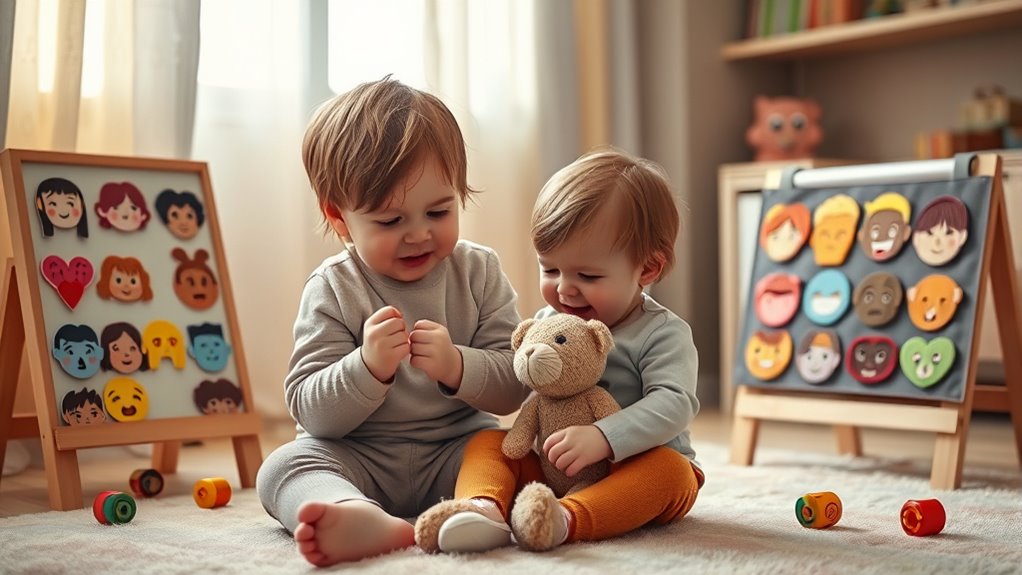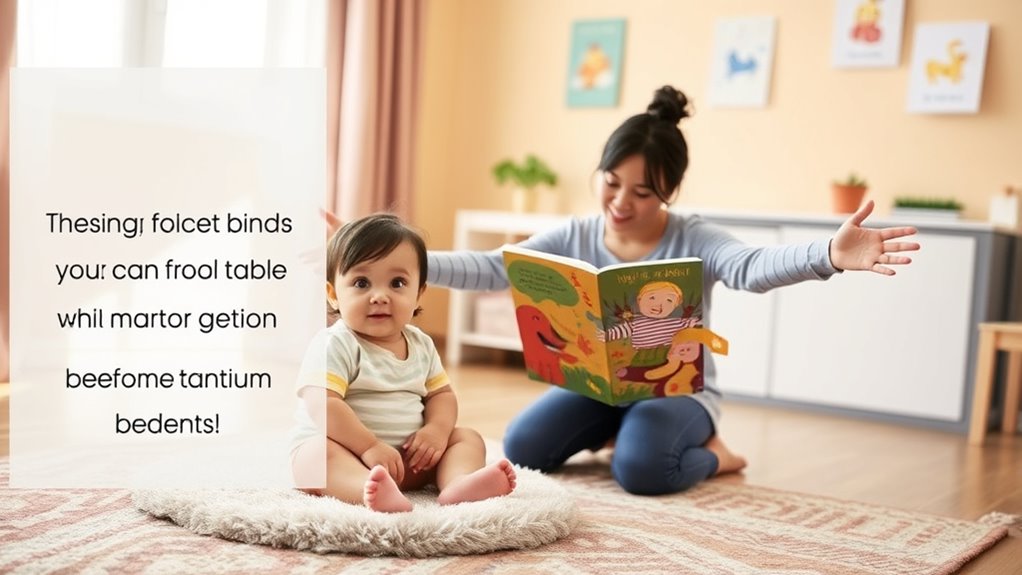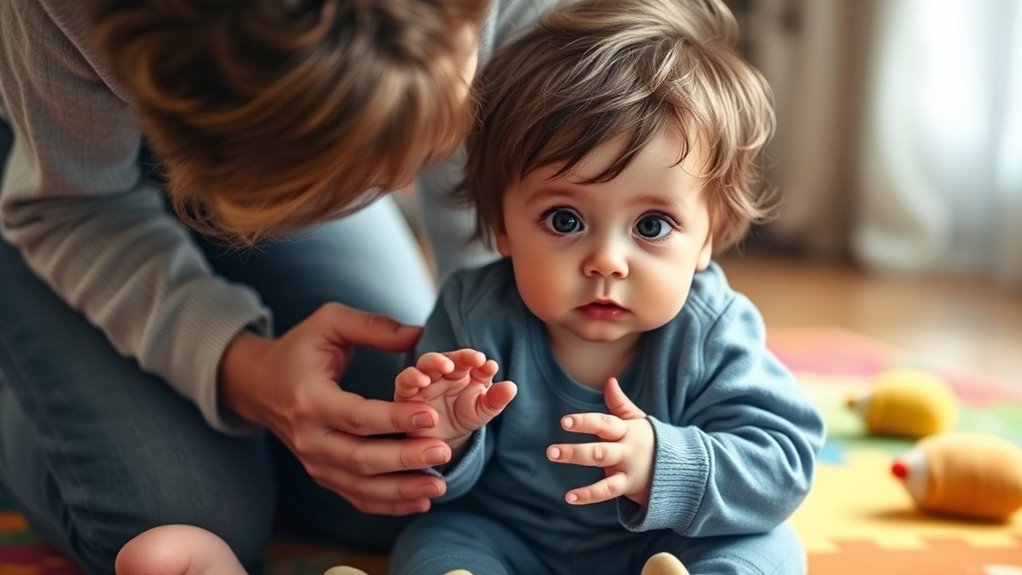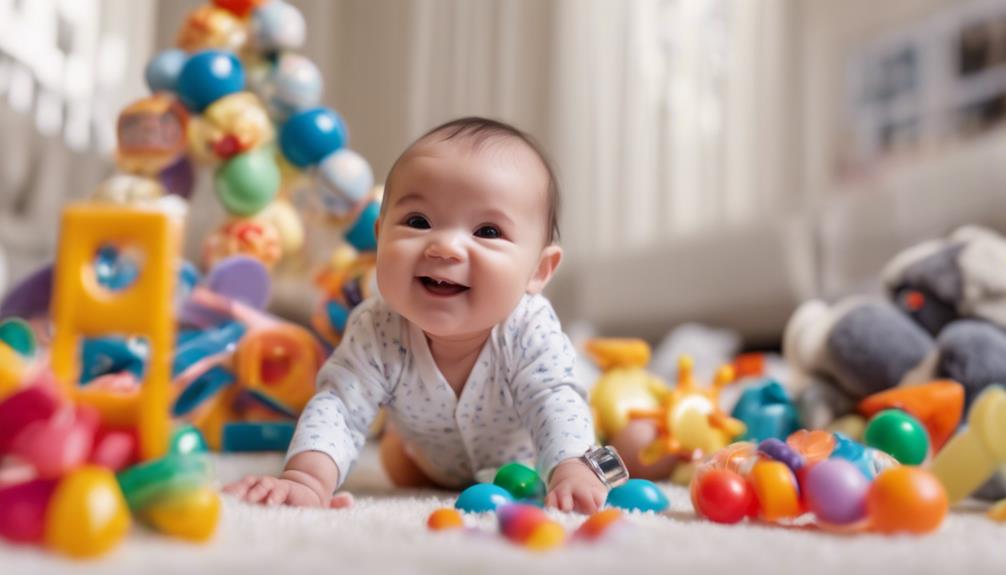To help your toddler cope with big emotions, start by noticing whether they’re having a tantrum or expressing true feelings. Validate their emotions with simple words and keep your responses calm and consistent. Create a peaceful environment, offer choices, and teach them words for their feelings to build emotional awareness. Using these strategies can prevent escalation and support your child’s growth. Keep exploring these tips to better manage those intense moments.
Key Takeaways
- Recognize early signs of frustration and differentiate between tantrums (impulsive, loud) and genuine feelings (calm, tearful).
- Respond calmly and consistently, acknowledging emotions without giving in, to promote emotional safety and understanding.
- Create a predictable routine and offer choices to reduce triggers and help toddlers feel in control.
- Use soothing techniques like gentle voice, comforting presence, and calming environment to de-escalate emotional outbursts.
- Teach and label feelings regularly through conversations and activities to build emotional vocabulary and regulation skills.
Recognizing the Difference Between Tantrums and Genuine Emotions

Understanding the difference between tantrums and genuine emotions is essential for helping your toddler cope effectively. When you develop emotional awareness, you can better interpret your child’s behavioral signals. A tantrum often looks intense but is typically a temporary outburst aimed at expressing frustration or seeking attention. Genuine emotions, like sadness or fear, tend to come with clear cues, such as tears, withdrawal, or quietness. Recognizing these signals helps you respond appropriately. If your child is overwhelmed with emotion, their behavior may be loud, physical, or impulsive—indications of a tantrum. Conversely, calm or subdued responses suggest your child is experiencing real feelings. By understanding these differences, you can support your child’s emotional development and teach healthy ways to express themselves. Being aware of emotional cues can guide you in providing the right support at the right time. Developing emotional regulation skills can further help your child manage their feelings more effectively. Additionally, understanding the differences between tantrums and feelings allows you to avoid unnecessary punishment and foster a trusting relationship. Recognizing the role of temperament can also help you tailor your responses to your child’s unique emotional needs. Moreover, understanding nutrition’s impact on mood can be beneficial, as a healthy diet supports emotional stability in children.
Validating Your Child’s Feelings to Promote Emotional Expression

Validating your child’s feelings is a powerful way to encourage healthy emotional development. When you practice feeling recognition, you show your child that their emotions are valid and understood. This act of emotional validation helps them feel safe expressing their feelings openly. Instead of dismissing or minimizing their emotions, acknowledge them with simple statements like, “I see you’re upset,” or “It’s okay to feel angry.” This approach teaches your toddler that emotions are normal and acceptable. By validating feelings, you foster trust and emotional awareness, which are essential for their social and emotional growth. Recognizing emotional responses can further support their understanding of their feelings and how to express them appropriately. Additionally, understanding emotional regulation can help caregivers guide children in managing their feelings more effectively. Remember, your response sets the foundation for how they will understand and manage their emotions in the future. Incorporating predictive analytics can help caregivers understand patterns in children’s emotional responses over time, further supporting their development.
Creating a Calm Environment During Emotional Outbursts

When your toddler has an emotional outburst, creating a calm environment can help them regain control and feel secure. Use soothing techniques like gentle voice tones, soft music, or a comforting presence to ease their distress. Environmental adjustments also play a key role—dim the lights, remove clutter, or create a quiet space where they can cool down. Keep your movements slow and deliberate to avoid escalating their emotions. Offering a familiar object, like a stuffed animal or blanket, can provide extra comfort. The goal is to reduce sensory overload and foster a sense of safety. Recognizing emotional regulation as a skill you can support in your child helps them learn to manage feelings more effectively. Incorporating space organization strategies can further create a serene environment that minimizes triggers. Utilizing sound design techniques such as gentle ambient sounds or soft music can significantly enhance the calming atmosphere. Empowering families with strategies like these helps children feel supported, making it easier for them to calm down and regain their composure.
Teaching Toddlers Words for Their Feelings

You can help your toddler understand their feelings by clearly naming emotions as they happen. Using specific feelings words like “angry,” “sad,” or “frustrated” makes it easier for them to express themselves. When you talk about feelings regularly, your child builds a strong vocabulary to handle big emotions. Incorporating emotion recognition into daily conversations can further enhance their understanding and management of feelings. Reinforcing these words through consistent labeling helps your child connect words with their experiences, making emotional understanding more intuitive. Regularly practicing mindfulness techniques can also create a calm environment that supports emotional regulation during both everyday moments and challenging situations. Understanding fetal development stages can also promote a calm environment during pregnancy, which benefits both mother and baby. Additionally, engaging in sound healing science techniques, such as calming vibrations, can help foster a peaceful atmosphere conducive to emotional growth.
Naming Emotions Clearly
Helping toddlers recognize and name their emotions is a crucial step in helping them manage big feelings. When you teach them feeling words, you boost their emotional literacy, making it easier for them to understand and express what they’re experiencing. Use simple, clear language to label emotions, like “angry,” “sad,” or “scared.” This helps toddlers connect their feelings to words, reducing confusion and frustration. To make this process engaging, try:
- Pointing out emotions during daily activities
- Using picture books with feeling words
- Naming your own emotions aloud
- Asking your toddler to identify feelings they see
- Repeating feeling words in different contexts
Using Feelings Vocabulary
Using feelings vocabulary is essential for toddlers to accurately identify and communicate their emotions. When you teach your child emotion vocabulary, you help them develop feeling identification skills that make it easier to express what they’re experiencing. Start by introducing simple, clear words like happy, sad, angry, and scared. Use these words consistently during daily routines and emotional moments to reinforce their understanding. Encourage your toddler to put feelings into words by asking questions like, “Are you feeling upset?” or “Can you tell me how you feel?” This ongoing practice helps them connect words to their emotions, making it easier to manage big feelings and reducing frustration. Building a strong emotion vocabulary empowers your child to communicate effectively and feel more in control of their emotions. Recognizing emotional growth stages in development can guide you in supporting their learning process, and understanding self-awareness can further enhance their emotional literacy.
Strategies for Preventing Tantrums Before They Start

Preventing tantrums before they start involves recognizing and addressing your toddler’s early signs of frustration or overstimulation. Establishing consistent parenting routines helps your child feel secure, reducing triggers for emotional outbursts. Enhancing emotional awareness means paying close attention to cues like whines, fidgeting, or eye-rolling, so you can intervene early. Here are some effective strategies:
- Keep a predictable daily schedule
- Offer choices to foster control
- Use calm, reassuring language
- Incorporate regular breaks for rest
- Monitor overstimulation signs and adjust activities accordingly
- Understanding emotional regulation can help you guide your child through managing intense feelings before they escalate into tantrums. Recognizing emotional cues allows caregivers to respond proactively and support their child’s emotional development effectively. Being attentive to emotional triggers can further prevent escalation by addressing issues before they become overwhelming.
Effective Ways to Respond During a Tantrum

When your toddler starts to have a tantrum, staying calm and consistent can make a big difference. Acknowledge their feelings without giving in, which helps them learn healthy coping mechanisms. If sibling jealousy sparks the tantrum, gently remind your child that their feelings are valid and reassure them of their importance. Avoid arguing or escalating the situation, as this can increase frustration. Instead, use a soothing voice, offer a distraction, or give them a moment to cool down. Recognize that tantrums are a way for your toddler to express big emotions they don’t yet fully understand. Responding with patience helps them develop emotional regulation. Over time, these responses teach your child how to manage intense feelings in a constructive way.
Supporting Your Toddler’s Emotional Development Over Time

Consistent emotional responses help your toddler feel secure and understand what to expect. Encouraging your child to express their feelings using words builds their emotional vocabulary. Over time, these strategies support their growth into confident and emotionally aware individuals.
Consistent Emotional Responses
Establishing predictable emotional responses helps your toddler feel secure and understand what to expect from you. When you’re consistent, you reinforce emotional consistency and behavioral predictability, which builds trust. Your child learns that their feelings are valid and that your reactions won’t change unexpectedly. To foster this, you can:
- Respond calmly, even during challenging moments
- Use similar phrases to acknowledge feelings
- Maintain steady facial expressions and tone
- Follow through with consistent consequences
- Show empathy regularly, reinforcing emotional safety
Promote Expressive Language
Encouraging your toddler to use expressive language is a pivotal step in helping them understand and manage their emotions. Through emotion coaching, you can model words that describe feelings, helping your child identify and express what they’re experiencing. Incorporate expressive storytelling into your daily interactions, narrating situations with emotion-focused language that resonates with your toddler. For example, say, “I see you’re upset because your block fell,” instead of just “Be careful.” This approach builds their vocabulary for feelings and empowers them to communicate when they’re overwhelmed. Over time, your consistent use of emotion coaching and expressive storytelling helps your toddler develop better emotional awareness and regulation skills, setting a foundation for healthier emotional development as they grow.
Frequently Asked Questions
How Can I Tell if My Toddler’s Feelings Are Age-Appropriate?
You might wonder if your toddler’s feelings are age-appropriate. Pay attention to their emotional milestones, which guide typical reactions for their age. For instance, it’s normal for toddlers to get upset over small changes or frustrations. If their reactions seem consistent with their developmental stage—like expressing joy, anger, or sadness in typical ways—you’re likely on the right track. Remember, each child’s emotional growth varies, so patience is key.
What Are Some Signs My Child Is Overwhelmed Emotionally?
When your child shows emotional cues or behavior signals, it’s a sign they might be overwhelmed. You’ll notice signs like crying, clinging, or withdrawal, and their reactions may seem exaggerated or inconsistent. These signals often indicate they’re struggling to process feelings. Pay close attention to their body language and responses; these cues help you understand when they need comfort, reassurance, or a calming environment to regain emotional balance.
How Do I Handle Guilt When My Child Tantrums in Public?
When your child tantrums in public, it’s normal to feel parental guilt and worry about public judgment. Remember, everyone understands children can have big emotions, and your response shows your care. Instead of dwelling on guilt, focus on calming your child and setting gentle boundaries. Leave the judgment behind—your patience and understanding help your child learn healthy emotional regulation. Trust yourself; you’re doing your best.
Are There Specific Activities to Help Toddlers Express Emotions Healthily?
You can help your toddler express emotions healthily through activities like art therapy and emotion games. Art therapy encourages them to draw or paint feelings, making it easier to identify and share emotions. Emotion games, such as role-playing or matching feelings to situations, teach kids to recognize and manage their feelings. These activities foster emotional awareness and provide safe outlets, helping your child develop healthy ways to express themselves.
When Should I Seek Professional Help for My Child’s Emotional Struggles?
When you notice your child’s emotions persist or escalate despite your efforts, it’s time to contemplate seeking professional help. While tantrums are typical, ongoing struggles may indicate underlying issues requiring an emotional assessment. Don’t wait until behaviors become overwhelming; early mental health support can make a significant difference. Trust your instincts, and consult a specialist if your child’s emotional struggles interfere with daily life or their well-being.
Conclusion
By understanding the difference between tantrums and genuine feelings, you create a safe harbor for your toddler’s emotions. Picture a calm lighthouse guiding a stormy sea, helping your child navigate their big feelings with your support. When you validate their emotions and respond with patience, you build a trusting sailboat ready to brave any emotional storm. Together, you’ll turn turbulent moments into opportunities for connection and growth on your shared journey.










